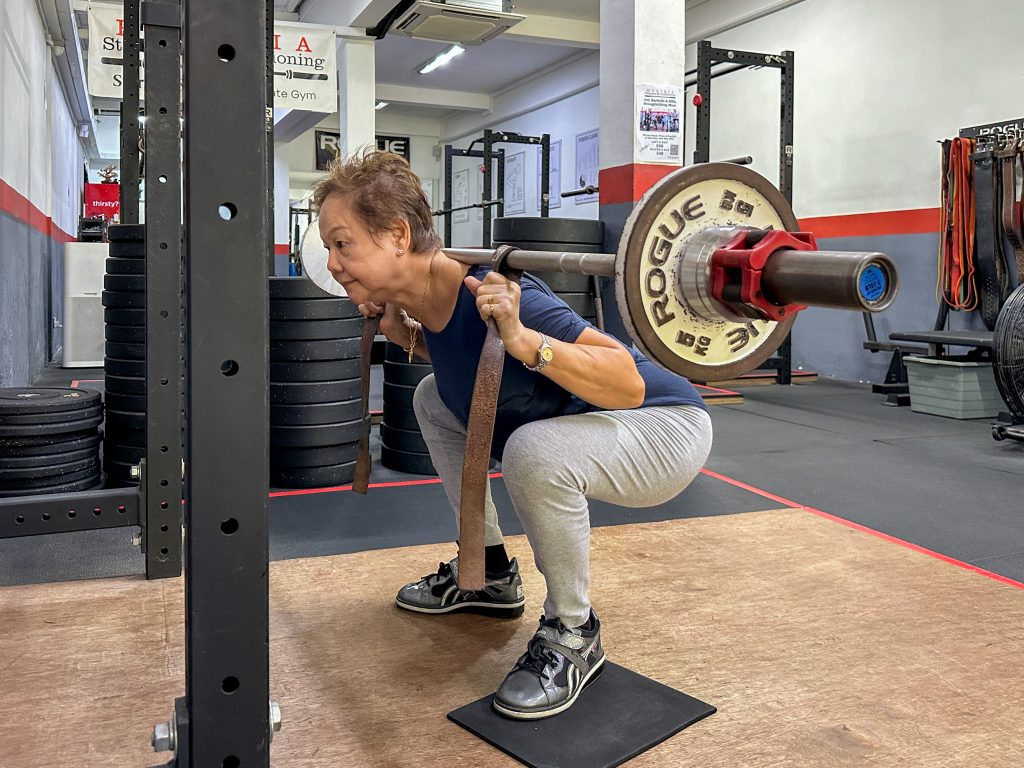
Imagine being diagnosed with osteoporosis and your doctor tells you that there is nothing you can do to manage the condition except take medication. That’s exactly what a prospective client was told after being diagnosed with osteoporosis. During our chat, She also mentioned that she noticed herself losing strength as she got older.
But when I explained that strength training not only builds muscle and strength but also increases bone density without medication – and this is proven by before and after medical scan results from our clients in the same demographic as her (like Connie and Miss C), she was surprised.
Over the years, many older adults have reached out to us to enquire about strength training and if it’s suitable for them. Some of them have the misconception that strength/muscle/bone loss is a one way street, and that they can’t get stronger or build muscle and bone because they’re older. Some are also intimidated by the idea of barbell training, thinking that it’s dangerous and not for them given their age.
But is it really too late to get stronger and increase bone density with barbell training?
Benefits of strength training for older adults
Strength training is not just for the young. In fact, it’s especially important older adults to train for strength and to be strong. Issues associated with ageing, such as general frailty, loss of physical independence, and the increased risk of falling and injury, can be circumvented by building strength, muscle and bone. In addition to that, being stronger has been shown to be a significant indicator of longevity and associated with a decreased risk of all-cause mortality.
Take Patricia, for example. She started strength training to manage her osteoporosis. Not only did she see her bone density improve and is no longer osteoporotic, but she also broke national powerlifting records along the way. And she’s not the only one. Others like Mr Ling, who picked up strength training for health reasons and went on to compete in a powerlifting meet, proving that you’re never too old to start.
But it’s not just the big success stories that matter. We also hear smaller yet significant victories every day. Clients like Raj report that their back pain disappeared after he started training – as they say, the cure for a weak back is a strong back. Others tell us, “I can now climb up stairs and chase after the bus effortlessly.”
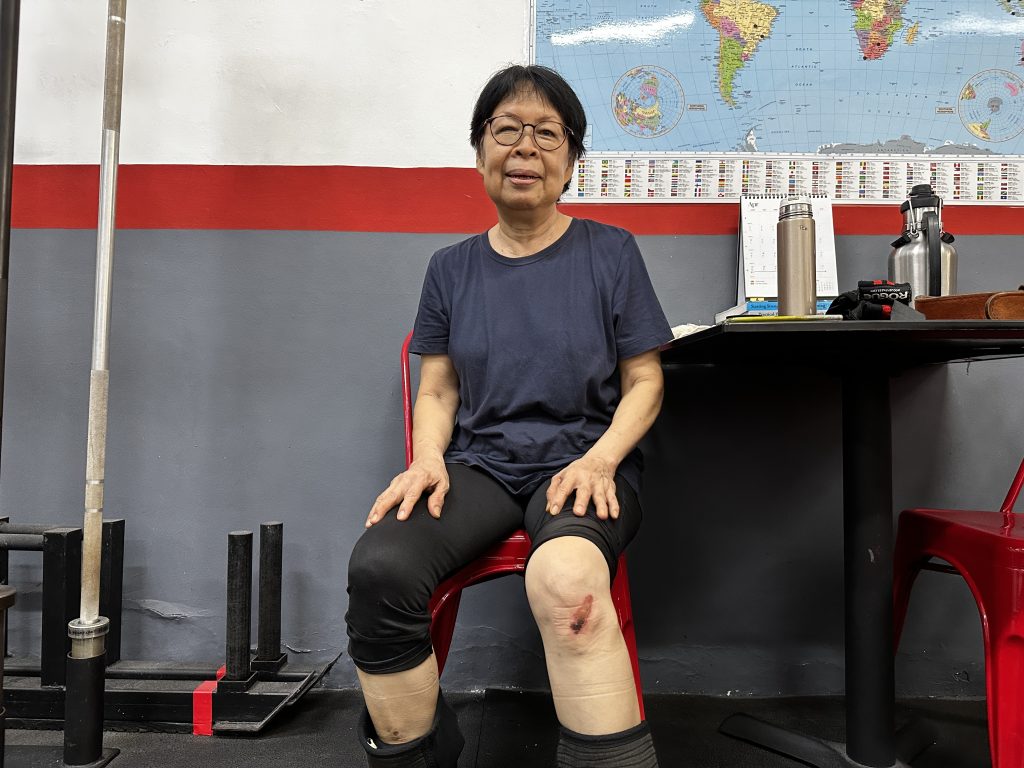
Connie once told us about a time she fell while crossing the road in the rain. She said, “I slipped and fell, but got up immediately on my own and kept going. Aside from a few minor cuts, I was fine – someone else my age could have fractured something.”
Talk about job satisfaction: we love seeing and hearing stories like this. Strength training truly is for everyone. It’s why we do what we do – getting older people strong.
The barbell lifts are for everyone
Many prospective clients ask what types of exercises they would be doing when they train with us, assuming there must be a special programme or exercises for older adults. The truth is, we use the same basic barbell lifts for everyone because it’s the best way to get strong, just adjusted to their abilities.
We explain the reason behind using the basic barbell lifts and doing them in a specific way, which is based on three key criteria for building strength:
1. Utilising the most amount of muscle mass
2. Over the longest effective range of motion
3. To allow for the use of the most weight possible
These principles are the foundation of effective strength training, regardless of age. Every human, unless dealing with compromised health, can get stronger because of the phenomenon known as the General Adaptation Syndrome, or the stress-recovery-adaptation cycle.
Training utilises this phenomenon to get one stronger and there are three phases: stress, recovery, and adaptation (SRA). During the stress phase, we apply a training stress above the person’s current level of adaptation (but not so much that the person is overwhelmed). Next is the recovery phase, when the body recovers from the training stress with sleep/rest and proper nutrition. If recovery is sufficient, the person adapts to the training stress. Repeating this process will strengthen your muscles, connective tissue, and bones.
This SRA cycle occurs regardless of your age. Whether you’re 9 or 90, this phenomenon doesn’t change; what’s different is the rate of adaptation. For older adults, we take into account the rate of increase of the training stress and that their recovery capacity is slower as compared to a younger lifter. But with the proper adjustments, they can still make significant progress.
“But barbell training looks very heavy and scary, isn’t it dangerous?” We need to address the myth that it’s dangerous to lift heavy weights, because barbell training is actually less risky than other sports. In fact, we’d argue that it’s a bigger risk not to train and stay weak, especially if you’re older.
Perhaps the thought of barbell strength training conjures up images of young guys straining hard to lift super heavy weights. I find it odd that when people are advised that they need to get some cardiovascular exercise in and should start jogging, they never think of Eliud Kipchoge and think “I can’t jog 42.195km, much less in under 2 hours!” Instead, they start off with what they can manage and gradually work their way up.
But when they are recommended to get strong with barbell training, their minds jump to images or videos of lifters straining under very heavy weights. While you may or may not eventually get to lifting these heavy weights you have in mind, you definitely don’t start that way. On your first day of training, you’ll learn how to do the barbell lifts and find a working weight that’s manageable for you, whatever it may be, and gradually work up from there.
In most commercial gyms, you’ll usually only find the standard 20kg Olympic barbell, which can be too heavy for new lifters. But in our gym, we offer a range of lighter barbells – 15kg, 7kg, 5kg. If needed, we have plastic pipes that can be used till the lifter gets strong enough to use the 5kg bar.
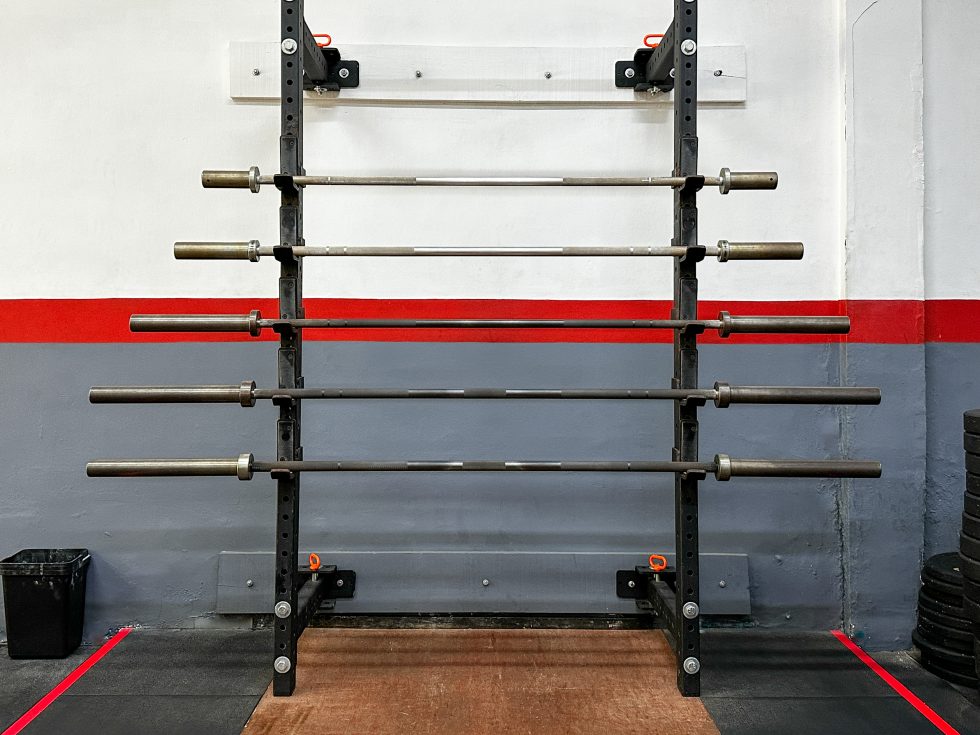
This ensures that even the newest lifter, regardless of age and level of strength, can start safely and work their way up. The lighter barbells have the same shaft dimensions as the 20kg barbells, so when the lifter transitions to the heavier barbell, it won’t feel different from what they’re familiar with.
Modifying the lifts for individual needs
Older adults often have aches, pains, and injuries accumulated from decades of being on this earth, or they can be so detrained that they don’t have the strength to perform the lifts as is. As such, modifications may be necessary to ensure their safety and to get the benefits of training.
While we strive to coach our lifters to perform the barbells according to Starting Strength method, we understand that some can’t perform them as prescribed. For these individuals, we’ll make adjustments to accommodate to their situation, aiming to stay as close to the Starting Strength model as possible with their limitations in mind.
For example, some older clients who are starting out may not be able to squat down to depth and stand back up due to strength limitations. We may start them with box squats, by stacking some bumper plates to a height they can safely sit and stand up from, then gradually lowering the height as they build strength. Once they’re able to squat to depth and get back up, we remove the stack of bumper plates, we’ll start adding load very gradually.
Wonky shoulders are common in older adults, especially older males. For squats, we prefer the low bar back squat because it allows the lifter to lift more weight. However, some older lifters lack the shoulder flexibility for the barbell to assume the low bar position on their backs. In these cases, we try a high bar position with the bar on the upper traps. If the issue is soft tissue-related, we might also start with a wider grip and gradually narrow it, sometimes transitioning to low bar if their flexibility improves over time.
If it’s a structural shoulder issue, we stick with the high bar squat. For lifters with a more limited shoulder range of motion (often post-surgery), we use a safety squat bar.
These adjustments ensure that the lifter is still getting the full benefit of strength training while accommodating their needs.
With years of experience working with hundreds of lifters, we can figure out the best approach to meet each lifter where they’re at. Once we’ve determined any necessary modifications and the appropriate starting weight (remember, it will be a manageable weight, and we have light bars for different strength levels), then it’s off to the races.
Proving progress with data
The real proof of strength training’s effectiveness can be seen in the results. We tracked the progress of our current clients aged 60-77, showing their strength improvement before and after. We monitor the different lifts (squats, deadlifts, bench and press), noting the weight they started with and the heaviest they’ve achieved.
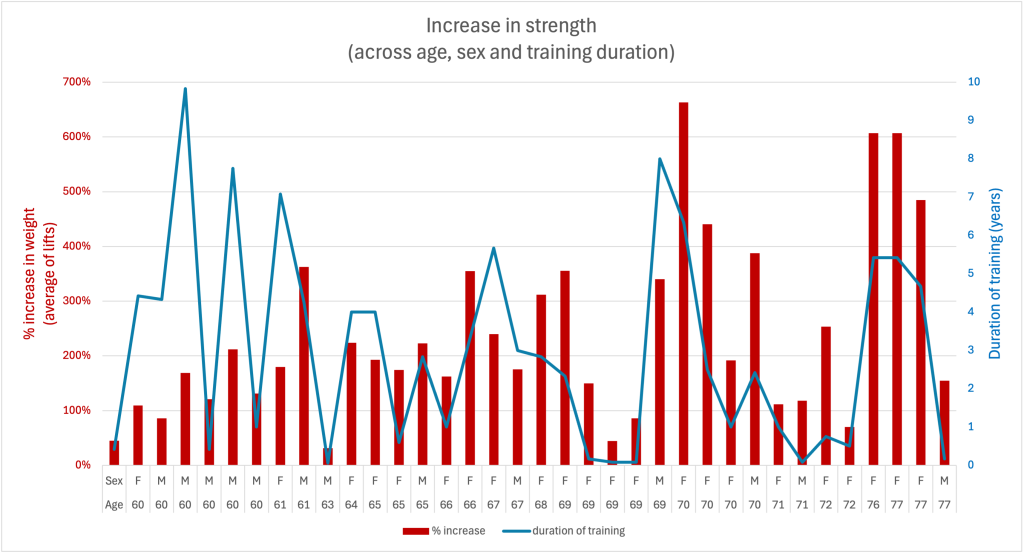
– For training duration (in blue): the shortest is 3 weeks, the longest is 9 years and 10 months, and the mean is just under 3 years.
– About strength increase (in red): we added up the percentage weight increase (before and after) for each of the 4 barbell lifts, and took the average. Where there was missing data because the lifter can’t perform a particular lift, that lift was removed.
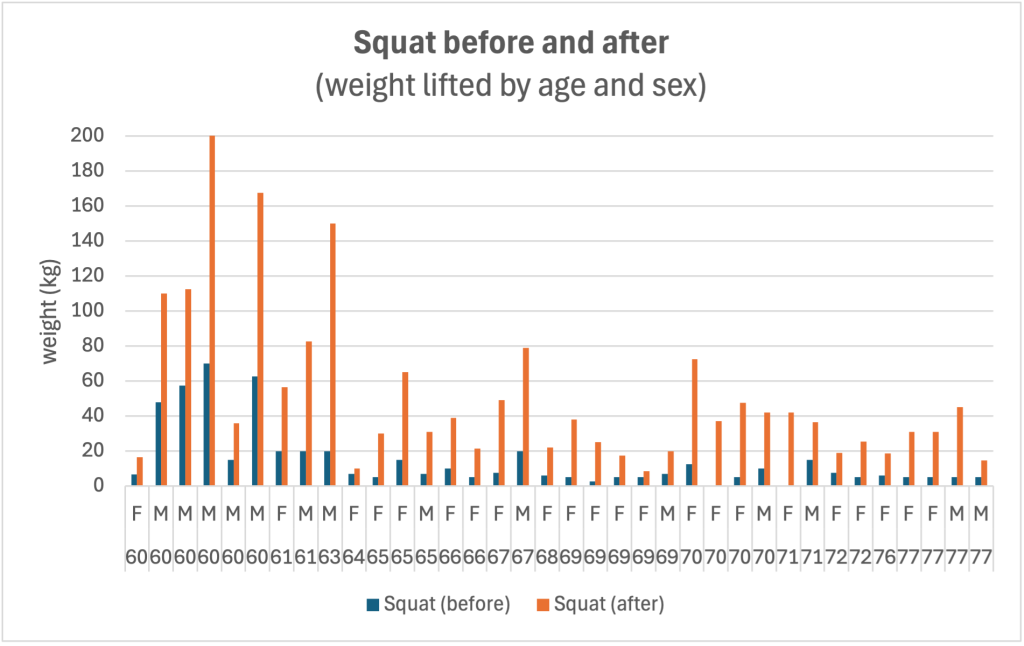
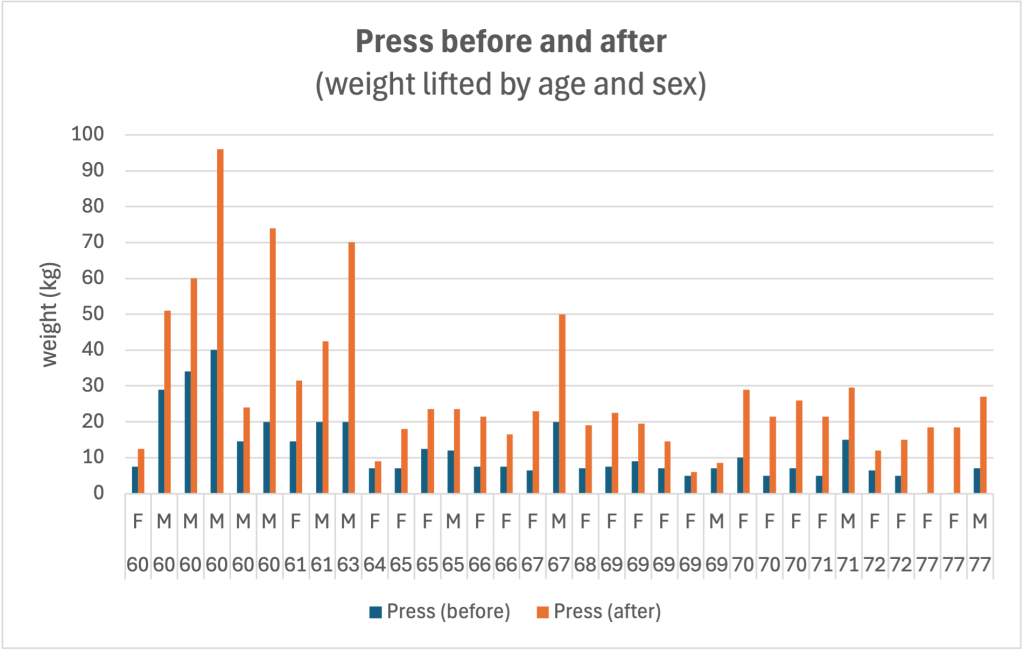
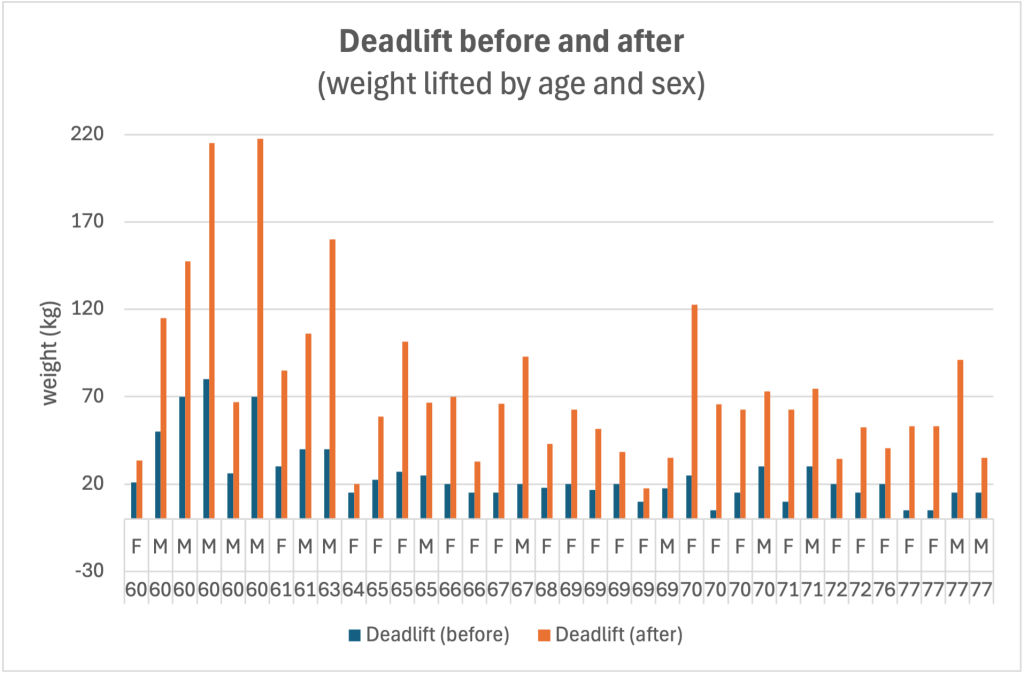
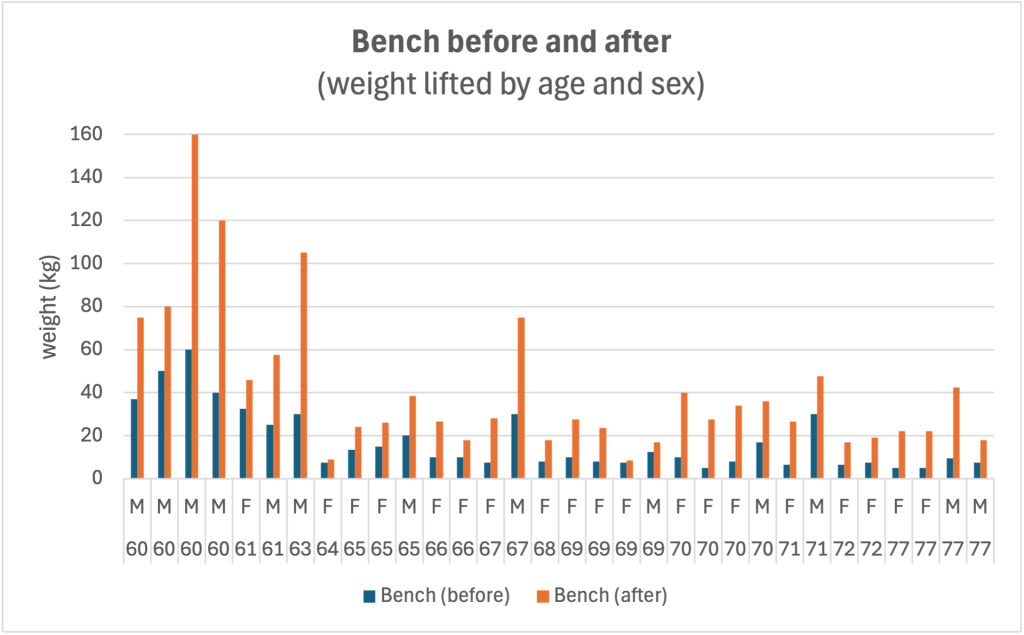
As you can see, while everyone started at a different point, the common thread is clear: everyone got stronger. There isn’t much correlation between duration and improvement; but what’s surprising is that the biggest improvements were the lifters in their ‘70s. And of the 4 lifters with huge improvements, 3 are female.
Some clients began with bodyweight high box squats because they weren’t strong enough to perform an unassisted bodyweight squat to depth and stand back up. Over time, they progressed to weighted squats. In other cases, clients started with variations, like rack pulls, and progressed to the deadlift over time.
This varied starting point and what they’ve achieved so far doesn’t change the result. Whether it’s a 60-year-old man deadlifting 100kg or a 70-year-old woman squatting 70kg, the key takeaway is that strength training works even for older adults, starting from any level.
It’s never too late to start
Our counterparts in the US have clients in their 90s! Find out more about them here and here. These amazing folks started lifting later in life and are still seeing incredible improvements in strength. Whether you’re just starting or getting back into it, the benefits are obvious at any age.
Our own coaches walk the talk – Coach Marvin’s success with getting his to mom train and Coach Ellie coaching her mother show that it’s possible to make a change at any stage of life. Beyond physical benefits, strength training also provides psychological advantages that help you age gracefully and live better in your golden years.
So why wait? It’s never too late to invest in your health by getting stronger. Take the first step today, and experience the benefits of strength training for yourself.

